Articles: Adoranten 2017
A miniature in amber of a battleaxe from the Battle-Axe Culture by Lars Larsson
 In the mid 1930s an amber object shaped like a miniature battle-axe was found in the northern part of Öland, an island in the Baltic Sea. The object is a very detailed copy of a true battle-axe in stone dating from the Battle-Axe Culture of the late Middle Neolithic. Miniature battle-axes in stone are not rare, but this is the only example made of amber. The findspot was situated in deep water during the Middle Neolithic, and so an alternative interpretation of the origin is presented. Although this is the only battle-axe in amber, other amber objects, such as ornaments, are known from the same cultural complex in southern Scandinavia. The paper also includes a survey of miniature battle-axes in amber from other cultures during the Neolithic in southern Scandinavia.
In the mid 1930s an amber object shaped like a miniature battle-axe was found in the northern part of Öland, an island in the Baltic Sea. The object is a very detailed copy of a true battle-axe in stone dating from the Battle-Axe Culture of the late Middle Neolithic. Miniature battle-axes in stone are not rare, but this is the only example made of amber. The findspot was situated in deep water during the Middle Neolithic, and so an alternative interpretation of the origin is presented. Although this is the only battle-axe in amber, other amber objects, such as ornaments, are known from the same cultural complex in southern Scandinavia. The paper also includes a survey of miniature battle-axes in amber from other cultures during the Neolithic in southern Scandinavia.
 In the mid 1930s an amber object shaped like a miniature battle-axe was found in the northern part of Öland, an island in the Baltic Sea. The object is a very detailed copy of a true battle-axe in stone dating from the Battle-Axe Culture of the late Middle Neolithic. Miniature battle-axes in stone are not rare, but this is the only example made of amber. The findspot was situated in deep water during the Middle Neolithic, and so an alternative interpretation of the origin is presented. Although this is the only battle-axe in amber, other amber objects, such as ornaments, are known from the same cultural complex in southern Scandinavia. The paper also includes a survey of miniature battle-axes in amber from other cultures during the Neolithic in southern Scandinavia.
In the mid 1930s an amber object shaped like a miniature battle-axe was found in the northern part of Öland, an island in the Baltic Sea. The object is a very detailed copy of a true battle-axe in stone dating from the Battle-Axe Culture of the late Middle Neolithic. Miniature battle-axes in stone are not rare, but this is the only example made of amber. The findspot was situated in deep water during the Middle Neolithic, and so an alternative interpretation of the origin is presented. Although this is the only battle-axe in amber, other amber objects, such as ornaments, are known from the same cultural complex in southern Scandinavia. The paper also includes a survey of miniature battle-axes in amber from other cultures during the Neolithic in southern Scandinavia.
Beauty Is More Than Skin Deep. -Ray Art Of North Australia. Including Kakadu National Park. By Paul Tacon
 For at least 4000 years Australian Aboriginal artists of the Top End of the Northern Territory have been depicting creatures by showing both internal and external features of the body. This began by including empty body cavities in otherwise solid or stroke infill paintings of animals and occasionally backbones represented with a thin line through a central body cavity (Figure 1; Taçon 1987, 1989a, 1989b). Over time the concern about the insides of things grew so that when Europeans arrived in this part of Australia, in the early to mid 1800s, artists were producing elaborately detailed works on rock walls and sheets of bark that showed many organs, bones and other internal aspects of anatomy of not only animals but also human figures. These designs delineate many features of bodies, in both naturalistic and abstract ways, with some paintings akin to scientific diagrams.
For at least 4000 years Australian Aboriginal artists of the Top End of the Northern Territory have been depicting creatures by showing both internal and external features of the body. This began by including empty body cavities in otherwise solid or stroke infill paintings of animals and occasionally backbones represented with a thin line through a central body cavity (Figure 1; Taçon 1987, 1989a, 1989b). Over time the concern about the insides of things grew so that when Europeans arrived in this part of Australia, in the early to mid 1800s, artists were producing elaborately detailed works on rock walls and sheets of bark that showed many organs, bones and other internal aspects of anatomy of not only animals but also human figures. These designs delineate many features of bodies, in both naturalistic and abstract ways, with some paintings akin to scientific diagrams.
 For at least 4000 years Australian Aboriginal artists of the Top End of the Northern Territory have been depicting creatures by showing both internal and external features of the body. This began by including empty body cavities in otherwise solid or stroke infill paintings of animals and occasionally backbones represented with a thin line through a central body cavity (Figure 1; Taçon 1987, 1989a, 1989b). Over time the concern about the insides of things grew so that when Europeans arrived in this part of Australia, in the early to mid 1800s, artists were producing elaborately detailed works on rock walls and sheets of bark that showed many organs, bones and other internal aspects of anatomy of not only animals but also human figures. These designs delineate many features of bodies, in both naturalistic and abstract ways, with some paintings akin to scientific diagrams.
For at least 4000 years Australian Aboriginal artists of the Top End of the Northern Territory have been depicting creatures by showing both internal and external features of the body. This began by including empty body cavities in otherwise solid or stroke infill paintings of animals and occasionally backbones represented with a thin line through a central body cavity (Figure 1; Taçon 1987, 1989a, 1989b). Over time the concern about the insides of things grew so that when Europeans arrived in this part of Australia, in the early to mid 1800s, artists were producing elaborately detailed works on rock walls and sheets of bark that showed many organs, bones and other internal aspects of anatomy of not only animals but also human figures. These designs delineate many features of bodies, in both naturalistic and abstract ways, with some paintings akin to scientific diagrams.
Blowing the Horn. Lure Images in Rock Art in Trøndelag, Norway by Kalle Sognnes
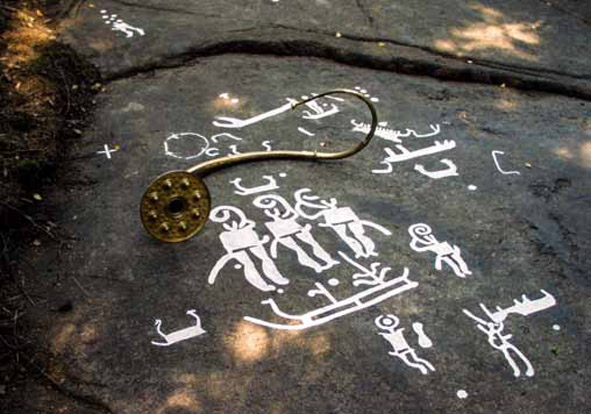 Among the many finds from Bronze Age Scandinavia (c. 1800-500 BC) is a collection of wind instruments (horns) casted in bronze. These wind instruments in modern times became known as lures; a name taken from traditional Scandinavian folk instruments used by herdsmen and in traditional folk music. According to Broholm (1965) 54 complete or fragmented bronze lures are known from northern Europe: 34 from Denmark, 11 from Sweden, four from Norway, five from northern Germany, and one from Estonia; virtually all being found within the area of the Nordic Bronze Age culture, the core area of which is in Denmark and southern Sweden. Later, Jensen (2002, 457-459) operated with 39 finds from Denmark and 13 from Sweden. The Norwegian examples are found at Revheim in Rogaland and Rossum in Oppland; the latter ones being fragmentary.
Among the many finds from Bronze Age Scandinavia (c. 1800-500 BC) is a collection of wind instruments (horns) casted in bronze. These wind instruments in modern times became known as lures; a name taken from traditional Scandinavian folk instruments used by herdsmen and in traditional folk music. According to Broholm (1965) 54 complete or fragmented bronze lures are known from northern Europe: 34 from Denmark, 11 from Sweden, four from Norway, five from northern Germany, and one from Estonia; virtually all being found within the area of the Nordic Bronze Age culture, the core area of which is in Denmark and southern Sweden. Later, Jensen (2002, 457-459) operated with 39 finds from Denmark and 13 from Sweden. The Norwegian examples are found at Revheim in Rogaland and Rossum in Oppland; the latter ones being fragmentary.
 Among the many finds from Bronze Age Scandinavia (c. 1800-500 BC) is a collection of wind instruments (horns) casted in bronze. These wind instruments in modern times became known as lures; a name taken from traditional Scandinavian folk instruments used by herdsmen and in traditional folk music. According to Broholm (1965) 54 complete or fragmented bronze lures are known from northern Europe: 34 from Denmark, 11 from Sweden, four from Norway, five from northern Germany, and one from Estonia; virtually all being found within the area of the Nordic Bronze Age culture, the core area of which is in Denmark and southern Sweden. Later, Jensen (2002, 457-459) operated with 39 finds from Denmark and 13 from Sweden. The Norwegian examples are found at Revheim in Rogaland and Rossum in Oppland; the latter ones being fragmentary.
Among the many finds from Bronze Age Scandinavia (c. 1800-500 BC) is a collection of wind instruments (horns) casted in bronze. These wind instruments in modern times became known as lures; a name taken from traditional Scandinavian folk instruments used by herdsmen and in traditional folk music. According to Broholm (1965) 54 complete or fragmented bronze lures are known from northern Europe: 34 from Denmark, 11 from Sweden, four from Norway, five from northern Germany, and one from Estonia; virtually all being found within the area of the Nordic Bronze Age culture, the core area of which is in Denmark and southern Sweden. Later, Jensen (2002, 457-459) operated with 39 finds from Denmark and 13 from Sweden. The Norwegian examples are found at Revheim in Rogaland and Rossum in Oppland; the latter ones being fragmentary.
Bridging the gap: rock art and archaeological context in the “Quattro Dossi” area (Capo di Ponte, Valcamonica, Italy) by Paolo Rondini and Alberto Marretta
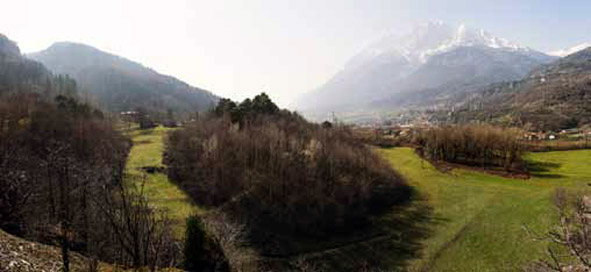 In recent years, University of Pavia and the Soprintendenza Archeologia della Lombardia have started a common research project, aimed at resuming the investigation in the “Quattro Dossi” archaeological area, one of the most interesting prehistoric sites in Valcamonica (UNESCO site n. 94, Italy), due to the combined presence of material remains and rock art. Previous research, conducted by Emmanuel Anati in the Dos dell’Arca portion of this area during the early sixties, was the first extensive archaeological excavation in Valcamonica, and while its original goal of studying both rock art and the material remains certainly was an exceptional scientific endeavour at the time, it never became standard practice, nor was it ever attempted again with the same ambition and scope.
In recent years, University of Pavia and the Soprintendenza Archeologia della Lombardia have started a common research project, aimed at resuming the investigation in the “Quattro Dossi” archaeological area, one of the most interesting prehistoric sites in Valcamonica (UNESCO site n. 94, Italy), due to the combined presence of material remains and rock art. Previous research, conducted by Emmanuel Anati in the Dos dell’Arca portion of this area during the early sixties, was the first extensive archaeological excavation in Valcamonica, and while its original goal of studying both rock art and the material remains certainly was an exceptional scientific endeavour at the time, it never became standard practice, nor was it ever attempted again with the same ambition and scope.
 In recent years, University of Pavia and the Soprintendenza Archeologia della Lombardia have started a common research project, aimed at resuming the investigation in the “Quattro Dossi” archaeological area, one of the most interesting prehistoric sites in Valcamonica (UNESCO site n. 94, Italy), due to the combined presence of material remains and rock art. Previous research, conducted by Emmanuel Anati in the Dos dell’Arca portion of this area during the early sixties, was the first extensive archaeological excavation in Valcamonica, and while its original goal of studying both rock art and the material remains certainly was an exceptional scientific endeavour at the time, it never became standard practice, nor was it ever attempted again with the same ambition and scope.
In recent years, University of Pavia and the Soprintendenza Archeologia della Lombardia have started a common research project, aimed at resuming the investigation in the “Quattro Dossi” archaeological area, one of the most interesting prehistoric sites in Valcamonica (UNESCO site n. 94, Italy), due to the combined presence of material remains and rock art. Previous research, conducted by Emmanuel Anati in the Dos dell’Arca portion of this area during the early sixties, was the first extensive archaeological excavation in Valcamonica, and while its original goal of studying both rock art and the material remains certainly was an exceptional scientific endeavour at the time, it never became standard practice, nor was it ever attempted again with the same ambition and scope.
Deep Time Rock Art in SW – Norway by Gitte Kjeldsen
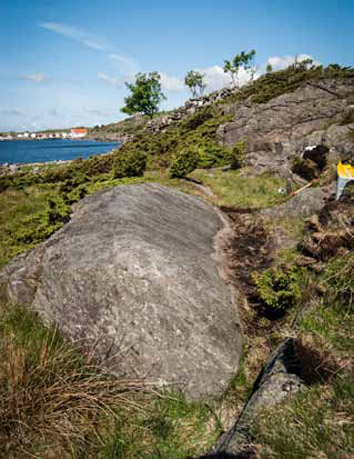 Rogaland in SW Norway has a large number of rock art sites within relatively limited geographical areas. I wish to present a longlived rock art tradition that marked places within the landscape using five examples of significant rock art sites and the difference in choice of place and imagery. The carving activity and the interaction with the rock may have reinforced personal relationship and may have impacted upon memories of those producing rock art and of the wider social memory of audience (Enlander 2016: 46-47) which was not forgotten through generations in the region.
Rogaland in SW Norway has a large number of rock art sites within relatively limited geographical areas. I wish to present a longlived rock art tradition that marked places within the landscape using five examples of significant rock art sites and the difference in choice of place and imagery. The carving activity and the interaction with the rock may have reinforced personal relationship and may have impacted upon memories of those producing rock art and of the wider social memory of audience (Enlander 2016: 46-47) which was not forgotten through generations in the region.
 Rogaland in SW Norway has a large number of rock art sites within relatively limited geographical areas. I wish to present a longlived rock art tradition that marked places within the landscape using five examples of significant rock art sites and the difference in choice of place and imagery. The carving activity and the interaction with the rock may have reinforced personal relationship and may have impacted upon memories of those producing rock art and of the wider social memory of audience (Enlander 2016: 46-47) which was not forgotten through generations in the region.
Rogaland in SW Norway has a large number of rock art sites within relatively limited geographical areas. I wish to present a longlived rock art tradition that marked places within the landscape using five examples of significant rock art sites and the difference in choice of place and imagery. The carving activity and the interaction with the rock may have reinforced personal relationship and may have impacted upon memories of those producing rock art and of the wider social memory of audience (Enlander 2016: 46-47) which was not forgotten through generations in the region.
Modern Religious Practices and the Preservation of Rock Art in India by Meenakshi Dubey-Pathak & Jean Clottes
 Except for Australia and a few other places, local people in the world no longer revere rock art. This is not so in India where beliefs in the supernatural power attached to painted sites are still strong. Those beliefs entail different types of behaviour, some respecting and protecting the sites and others detrimental to them.
For example, near Bhilani in the Raisen District of Madhya Pradesh, members of the Banjara Tribe told us that their grandparents revealed to them that on full moon nights and on no moon nights they would hear sounds of music and dances from the nearby Putli Karar painted shelters: the images would then dance. As a consequence, still now, people do not often visit those powerful sites that keep protected and intact.
When ceremonies take place in or around painted sites they may take three different forms which will differently impact the art. The first one is the least harmful, when people from local tribes, often under the leadership of a local “priest” or “shaman”, go to the sites to worship for various festivals. They will make offerings to the gods and they may touch the walls and add a few fingerprints or handprints without doing any great harm.
Except for Australia and a few other places, local people in the world no longer revere rock art. This is not so in India where beliefs in the supernatural power attached to painted sites are still strong. Those beliefs entail different types of behaviour, some respecting and protecting the sites and others detrimental to them.
For example, near Bhilani in the Raisen District of Madhya Pradesh, members of the Banjara Tribe told us that their grandparents revealed to them that on full moon nights and on no moon nights they would hear sounds of music and dances from the nearby Putli Karar painted shelters: the images would then dance. As a consequence, still now, people do not often visit those powerful sites that keep protected and intact.
When ceremonies take place in or around painted sites they may take three different forms which will differently impact the art. The first one is the least harmful, when people from local tribes, often under the leadership of a local “priest” or “shaman”, go to the sites to worship for various festivals. They will make offerings to the gods and they may touch the walls and add a few fingerprints or handprints without doing any great harm.
 Except for Australia and a few other places, local people in the world no longer revere rock art. This is not so in India where beliefs in the supernatural power attached to painted sites are still strong. Those beliefs entail different types of behaviour, some respecting and protecting the sites and others detrimental to them.
For example, near Bhilani in the Raisen District of Madhya Pradesh, members of the Banjara Tribe told us that their grandparents revealed to them that on full moon nights and on no moon nights they would hear sounds of music and dances from the nearby Putli Karar painted shelters: the images would then dance. As a consequence, still now, people do not often visit those powerful sites that keep protected and intact.
When ceremonies take place in or around painted sites they may take three different forms which will differently impact the art. The first one is the least harmful, when people from local tribes, often under the leadership of a local “priest” or “shaman”, go to the sites to worship for various festivals. They will make offerings to the gods and they may touch the walls and add a few fingerprints or handprints without doing any great harm.
Except for Australia and a few other places, local people in the world no longer revere rock art. This is not so in India where beliefs in the supernatural power attached to painted sites are still strong. Those beliefs entail different types of behaviour, some respecting and protecting the sites and others detrimental to them.
For example, near Bhilani in the Raisen District of Madhya Pradesh, members of the Banjara Tribe told us that their grandparents revealed to them that on full moon nights and on no moon nights they would hear sounds of music and dances from the nearby Putli Karar painted shelters: the images would then dance. As a consequence, still now, people do not often visit those powerful sites that keep protected and intact.
When ceremonies take place in or around painted sites they may take three different forms which will differently impact the art. The first one is the least harmful, when people from local tribes, often under the leadership of a local “priest” or “shaman”, go to the sites to worship for various festivals. They will make offerings to the gods and they may touch the walls and add a few fingerprints or handprints without doing any great harm.
The Pipette-Design in Desert Andes Rock Art by Maarten van Hoek
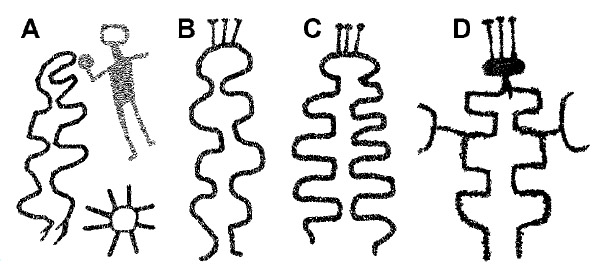 It is understandable that - in general - the design of the ‘pipette’ in the rock art of North and South America will at first sight be described as a non-figurative figure. It is a typically stacked design comprising (near) rectangular boxes, joined by a narrow passage (Russell and Wright 2008: Fig. 4n). However, there are several instances where such pipettes clearly appear to have been anthropomorphised (by the same hand at the same time, or possibly [much] later); at least to our western minds. This may have been achieved rather subtly by adding just two dots or small circles for eyes and in some cases a nose and a mouth (Russell and Wright 2008: Fig. 5o), or more unequivocally by - for instance - adding arms and legs or feet. In my opinion some (but definitely not all) of those anthropomorphised pipettes should be admitted as true anthropomorphic figures as well. However, there is much confusion as to what to accept as a pipette.
It is understandable that - in general - the design of the ‘pipette’ in the rock art of North and South America will at first sight be described as a non-figurative figure. It is a typically stacked design comprising (near) rectangular boxes, joined by a narrow passage (Russell and Wright 2008: Fig. 4n). However, there are several instances where such pipettes clearly appear to have been anthropomorphised (by the same hand at the same time, or possibly [much] later); at least to our western minds. This may have been achieved rather subtly by adding just two dots or small circles for eyes and in some cases a nose and a mouth (Russell and Wright 2008: Fig. 5o), or more unequivocally by - for instance - adding arms and legs or feet. In my opinion some (but definitely not all) of those anthropomorphised pipettes should be admitted as true anthropomorphic figures as well. However, there is much confusion as to what to accept as a pipette.
 It is understandable that - in general - the design of the ‘pipette’ in the rock art of North and South America will at first sight be described as a non-figurative figure. It is a typically stacked design comprising (near) rectangular boxes, joined by a narrow passage (Russell and Wright 2008: Fig. 4n). However, there are several instances where such pipettes clearly appear to have been anthropomorphised (by the same hand at the same time, or possibly [much] later); at least to our western minds. This may have been achieved rather subtly by adding just two dots or small circles for eyes and in some cases a nose and a mouth (Russell and Wright 2008: Fig. 5o), or more unequivocally by - for instance - adding arms and legs or feet. In my opinion some (but definitely not all) of those anthropomorphised pipettes should be admitted as true anthropomorphic figures as well. However, there is much confusion as to what to accept as a pipette.
It is understandable that - in general - the design of the ‘pipette’ in the rock art of North and South America will at first sight be described as a non-figurative figure. It is a typically stacked design comprising (near) rectangular boxes, joined by a narrow passage (Russell and Wright 2008: Fig. 4n). However, there are several instances where such pipettes clearly appear to have been anthropomorphised (by the same hand at the same time, or possibly [much] later); at least to our western minds. This may have been achieved rather subtly by adding just two dots or small circles for eyes and in some cases a nose and a mouth (Russell and Wright 2008: Fig. 5o), or more unequivocally by - for instance - adding arms and legs or feet. In my opinion some (but definitely not all) of those anthropomorphised pipettes should be admitted as true anthropomorphic figures as well. However, there is much confusion as to what to accept as a pipette.
The Spear - Digital documentation sheds new light on Early Bronze Age spear carvings from Sweden – an analysis with some comparative examples from Valcamonica, Italy by Ulf Bertilsson
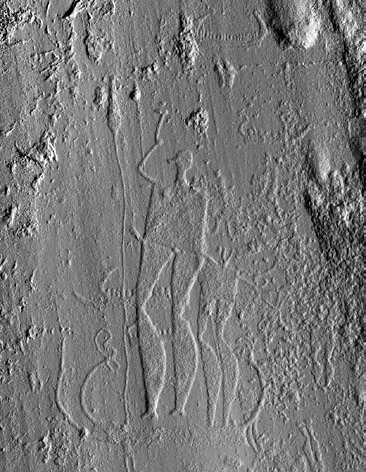 Depictions of metal weapons such as spears, swords, and axes are frequent in the Swedish Bronze Age rock carvings of Bohuslän, Uppland, Östergötland, and Skåne. Most images are non-representational and mostly portray the object type rather generically. Occasionally, the carvings exhibit details of the objects including the shape of the hilt, ferrule (or butt-spike), and scabbard, so as to suggest that they are images of real artefacts that existed during the Bronze Age. It is at times possible to determine precisely the type and chronology of the object depicted. This is the case, for example, with the swords shown on the Ekenberg rock carving in Norrköping (Östergötland), which compare to actual Bronze Age swords from the archaeological collections of the Stockholm Historical Museum (Bertilsson 2015; Hildebrand 1869,). It has often been argued that most of the weapons depicted in Swedish rock art are to be dated to the Late Bronze Age, in particular to Period V (c. 920-720 BC; Vogt 2011). However, detailed analysis of the carvings, including the digital-technology analysis presented here, indicate that this may not be the case, as a number of carvings appear to depict spear types from the Early Bronze Age, 1750 -1100 BC.
Depictions of metal weapons such as spears, swords, and axes are frequent in the Swedish Bronze Age rock carvings of Bohuslän, Uppland, Östergötland, and Skåne. Most images are non-representational and mostly portray the object type rather generically. Occasionally, the carvings exhibit details of the objects including the shape of the hilt, ferrule (or butt-spike), and scabbard, so as to suggest that they are images of real artefacts that existed during the Bronze Age. It is at times possible to determine precisely the type and chronology of the object depicted. This is the case, for example, with the swords shown on the Ekenberg rock carving in Norrköping (Östergötland), which compare to actual Bronze Age swords from the archaeological collections of the Stockholm Historical Museum (Bertilsson 2015; Hildebrand 1869,). It has often been argued that most of the weapons depicted in Swedish rock art are to be dated to the Late Bronze Age, in particular to Period V (c. 920-720 BC; Vogt 2011). However, detailed analysis of the carvings, including the digital-technology analysis presented here, indicate that this may not be the case, as a number of carvings appear to depict spear types from the Early Bronze Age, 1750 -1100 BC.
 Depictions of metal weapons such as spears, swords, and axes are frequent in the Swedish Bronze Age rock carvings of Bohuslän, Uppland, Östergötland, and Skåne. Most images are non-representational and mostly portray the object type rather generically. Occasionally, the carvings exhibit details of the objects including the shape of the hilt, ferrule (or butt-spike), and scabbard, so as to suggest that they are images of real artefacts that existed during the Bronze Age. It is at times possible to determine precisely the type and chronology of the object depicted. This is the case, for example, with the swords shown on the Ekenberg rock carving in Norrköping (Östergötland), which compare to actual Bronze Age swords from the archaeological collections of the Stockholm Historical Museum (Bertilsson 2015; Hildebrand 1869,). It has often been argued that most of the weapons depicted in Swedish rock art are to be dated to the Late Bronze Age, in particular to Period V (c. 920-720 BC; Vogt 2011). However, detailed analysis of the carvings, including the digital-technology analysis presented here, indicate that this may not be the case, as a number of carvings appear to depict spear types from the Early Bronze Age, 1750 -1100 BC.
Depictions of metal weapons such as spears, swords, and axes are frequent in the Swedish Bronze Age rock carvings of Bohuslän, Uppland, Östergötland, and Skåne. Most images are non-representational and mostly portray the object type rather generically. Occasionally, the carvings exhibit details of the objects including the shape of the hilt, ferrule (or butt-spike), and scabbard, so as to suggest that they are images of real artefacts that existed during the Bronze Age. It is at times possible to determine precisely the type and chronology of the object depicted. This is the case, for example, with the swords shown on the Ekenberg rock carving in Norrköping (Östergötland), which compare to actual Bronze Age swords from the archaeological collections of the Stockholm Historical Museum (Bertilsson 2015; Hildebrand 1869,). It has often been argued that most of the weapons depicted in Swedish rock art are to be dated to the Late Bronze Age, in particular to Period V (c. 920-720 BC; Vogt 2011). However, detailed analysis of the carvings, including the digital-technology analysis presented here, indicate that this may not be the case, as a number of carvings appear to depict spear types from the Early Bronze Age, 1750 -1100 BC.
Updating Rock Art. Re-cut rock art images (with a special emphasis on ship carvings) by Gerhard Milstreu
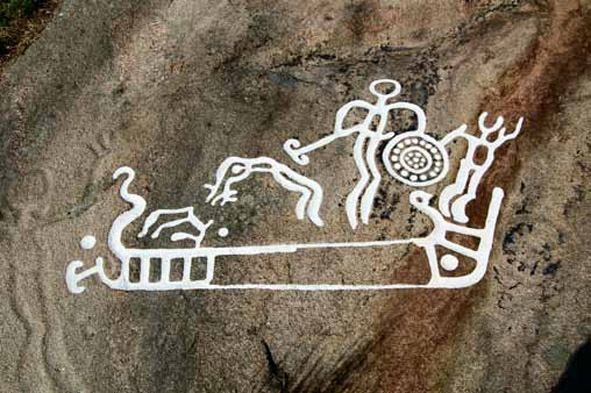 This article discusses the re-cutting of rock art ships. It shows how some boats were remade to update the boat style so that it corresponded with what was current in a period that was later than when it was first cut. The article points out the need for more in-depth studies to understand the creation and use of rock art over an extended period. It is argued that rock art sites are connected to social traditions that made people return to the same place and make changes to already existing images.
This article discusses the re-cutting of rock art ships. It shows how some boats were remade to update the boat style so that it corresponded with what was current in a period that was later than when it was first cut. The article points out the need for more in-depth studies to understand the creation and use of rock art over an extended period. It is argued that rock art sites are connected to social traditions that made people return to the same place and make changes to already existing images.
 This article discusses the re-cutting of rock art ships. It shows how some boats were remade to update the boat style so that it corresponded with what was current in a period that was later than when it was first cut. The article points out the need for more in-depth studies to understand the creation and use of rock art over an extended period. It is argued that rock art sites are connected to social traditions that made people return to the same place and make changes to already existing images.
This article discusses the re-cutting of rock art ships. It shows how some boats were remade to update the boat style so that it corresponded with what was current in a period that was later than when it was first cut. The article points out the need for more in-depth studies to understand the creation and use of rock art over an extended period. It is argued that rock art sites are connected to social traditions that made people return to the same place and make changes to already existing images.

|

